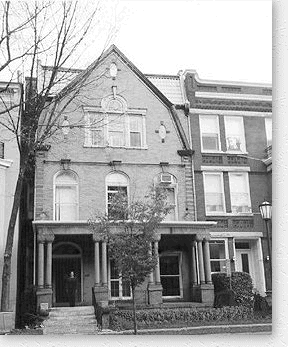 |
Old houses hold a variety of memories within their walls. Such a house is located at 920 West Franklin Street. Today, it is a house used by Virginia Commonwealth University's honors students, and academic administrators. Its wide arches have been converted to narrow doors, its large rooms portioned into offices, and its many fireplaces rendered inoperative. Still, its former architectural beauty can be seen, and the spirit of its first owner can be felt. If it could be given the power to speak, it would tell a powerful story, a poignant story, a story of a woman named Mary and her special place in the history of Richmond. |
| Mary Evans Pegram was born in 1832. Her
father, James West Pegram, was a general in the Virginia Militia, and her mother, Virginia
Johnson Pegram, was the daughter of a successful Virginia horse breeder. When Mary's
father became president of the Bank of Virginia, her family moved from Petersburg to
Richmond. For the Pegrams, life in Richmond was reflective of their status and style
until the general's death in a steam boat explosion on the Ohio River in 1844. Left with
limited resources, Mary's family was forced to struggle for survival. After living in several different places, Mrs. Virginia Johnson Pegram moved her children to 106-108 Franklin Street in Richmond's Linden Row, where she operated a school for young women. While Mrs. Pegram supported her family by teaching school, Mary looked after her younger sister Virginia and her three younger brothers: John, James West, and William. After her brothers and sister grew up, Mary Pegram continued to teach in her mother's school. But then, the Confederates fired on Fort Sumter and Mary's life was forever changed. Richmonders celebrated their succession from the Union. From her home in Linden Row, Mary could see the torchlight parades and the Confederate banners flying over Richmond's buildings. Soon, she sadly told her three brothers goodbye as they left Richmond to fight to establish a Southern nation. While her brothers fought on the far-flung battlefields, Mary continued to help her
mother in the school on Franklin Street. Occasionally, she could hear the cannon's roar
during the battles around Richmond and see the Confederate soldiers marching down Franklin
Street. In the winter months, the girls in Mrs. Pegram's school would frequently gather in
front of the building and toss snowballs at the passing soldiers. Sometimes, the soldiers
fired back. These moments of frivolity were rare in wartime Richmond; but the Pegrams,
like other Mary's family, it was said, was fortunate. Although the war had killed thousands of young men, the "fighting Pegrams" had survived. Now the war was drawing to its conclusion; additional sacrifices by the men in gray could not save the Confederate nation. It was at this time that the Pegram family was plunged into grief. Mary's brother John, a brigadier general, was killed at Hatcher's Run, west of Petersburg in February of 1865. His funeral was conducted exactly three weeks after the day of his wedding to the beautiful Hetty Cary of Baltimore. In April, her brother William fell, mortally wounded, in front of his cannon at Five Forks, Virginia. This gloom of despair deepened even more when Richmond was burned; when Lee surrendered at Appomattox Court House; and when the tattered Confederates straggled home in front of Mary's house on Franklin Street. Of the three brothers who had gone off to fight a war, only James West returned home to Richmond when this American tragedy was over. From her deep faith, Mary Pegram found the strength to endure the tragedy which
decimated her family in a cause that was now lost. She continued her teaching in schools
in Richmond, Baltimore, and New York. Then, she returned to Richmond in the 1880's and
married General James Anderson, a distinguished Richmonder who had managed the Tredegar
Iron Works during the war. The general and his bride lived at 113 West Franklin Street.
Their home was the center of the Richmond social scene and one can almost sense the
elegance of Mrs. Mary Pegram Anderson. Of this home, it was written that it had "been
graced by the presence of every stranger of note who had visited the city...." Mary's
happiness ended in 1892 when her husband died after a marriage of less than ten years.
Following his death, Mary Evans Pegram Anderson sold her home at 113 West Franklin to
Lewis Ginter, who later built the Jefferson Hotel on the site. Three is no way to know how many times Mary Pegram Anderson might have reflected on the past while living at 920 West Franklin. Perhaps she recalled her father who was killed while she was still a child. Maybe she remembered those difficult years when her mother struggled to provide for her family. Surely she reflected on the death of her two brothers and the destruction of the old South. Certainly she wondered why, when she had finally found happiness in marriage, her marriage had been far too short. Yet Mary Pegram Anderson was a proud woman who did not bend under adversity. Socially, she was described "as a sensitive Southern woman, of fine intellect, wit, dignity, and grace." One author recalled: "Slight in stature, but very erect, and possessing unusual distinction of manner and speech, no one who ever saw this dear lady of the old regime in her own home, or walking or driving in the streets of Richmond, or passing down the middle aisle of St. Paul's Church to her pew there, could ever forget her appearance !" Source: Walter S. Griggs, Jr., School of Business, Virginia Commonwealth University |
|